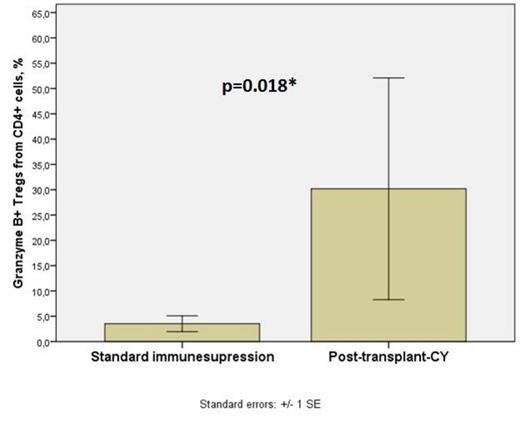Abstract
Introduction
Allogenic bone marrow transplantation (allo-HSCT) with high-dose, post-transplantation cyclophosphamide (CY) nowadays has become an alternative for standard immunosuppression. Many groups have shown that high dose CY after allo-HSCT selectively deplete alloreactive T effector cells and downregulate Granzyme B expression in CD8+ T and NK cells after allogeneic HSCT. Despite that fact there is no data about other T cell populations, such as Tregs and their immunosuppression abilities after post-transplant CY. We studied Granzyme B expression in Treg on day +14 after allo-HSCT with post-transplant CY and standard immunosuppression.
Patients and methods.
Peripheral blood samples were collected in EDTA-tubes at day +14 after allo-HSCT in patients with hematological malignancies with post-BMT-CY alone (n=8) and patients with standard immunosuppression (post-HSCT CSA, MMF or MTX at standard dose) (n=18). The anti-CD4-PE-Cy7, anti-CD25-APC, anti-CD127-FITC and anti-Granzyme B-PE (Becton Dickinson, USA) antibodies were used to determine Treg cells population as CD4+ CD25high CD127low. We did not include anti-FoxP3 antibodies as FoxP3 is not so specific in humans and particularly after allo-HSCT due to technical difficulties, several isoforms and etc. CD4- lymphocytes (certainly containing CD8+ and NK-cells population that obligatorily express granzyme B) were used as internal positive control to define population of CD4+ CD25high CD127low GranzymeB+ cells and gMFI (geometric mean fluorescence intensity). 50000 of CD4+ cells were analyzed on a BD FACSCanto II (Becton Dickinson, USA).
Results. Mann-Whitney U test was used to test for differences between Granzyme B+ Treg cells after post-transplant-CY alone and in a group of standard immunosuppression. The percent of CD4+ CD25high CD127low GranzymeB+ cells among CD4+ cells at day +14 after post-transplant CY alone was statistically higher (30.1±21,9; p=0.018*) than in patients with standard immunosuppression (3,52±1,56) (see Chart 1). There is no differences in Granzyme B expression (gMFI) in CD4+ CD25high CD127low cells after post-transplant-CY (2131,8±412,7) alone and in a group of standard immunosuppression (1718,17±316,8; p=0.541). It's worth to note that probably this mechanism in combination with depletion of alloreactive T effector cells and downregulation of Granzyme B expression in CD8+ T and NK cells help to prevent aGVHD in this group of patients.
Conclusion We suggest that post-transplant CY spares Granzyme B expression in Tregs in a patients with post-transplant-CY and help to prevent aGVHD development in this group of patients. Despite the fact that the analyzed group is small, obtained data is important and needs further investigation.
Granzyme B expression in Tregs after post-transplant-CY alone and in a group of standard immunosuppression.
Granzyme B expression in Tregs after post-transplant-CY alone and in a group of standard immunosuppression.
No relevant conflicts of interest to declare.
Author notes
Asterisk with author names denotes non-ASH members.


This feature is available to Subscribers Only
Sign In or Create an Account Close Modal